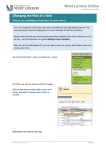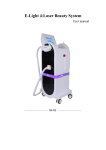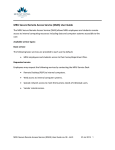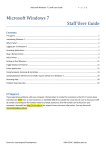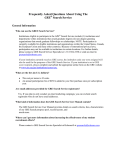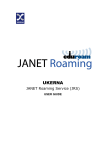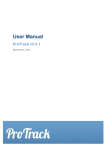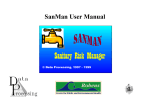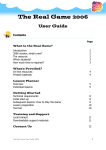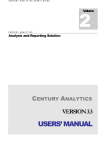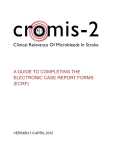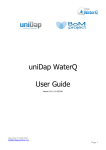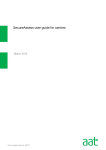Download OMR manual - Trinity College Dublin
Transcript
Optical Mark Reader (OMR) Manual IT Services, Trinity College Dublin Version 2.6 Sept 2015 Table of contents Before the exam:................................................................................................................ 3 This Optical Mark Reader (OMR) Manual...................................................................... 3 IT Services Policy on OMR support ................................................................................ 3 For the examiner ........................................................................................................... 3 For the examinees ......................................................................................................... 4 Before Processing: ............................................................................................................. 5 After Processing: ................................................................................................................ 5 Tab delimited list of students ........................................................................................ 6 The OMR Start/Stop Button (ie the Green button) ....................................................... 8 Processing your exam results: ........................................................................................... 9 Getting Started .............................................................................................................. 9 Exam types and styles.................................................................................................... 9 Exam types ................................................................................................................ 9 Exam styles: ............................................................................................................... 9 Selecting the exam type and style ............................................................................... 10 Designing your own exam style............................................................................... 11 Assigning a name to the Response file ........................................................................ 11 Reading in student names ........................................................................................... 12 Reading in the Correct Answers (Master) sheet.......................................................... 14 Withdrawing a Question.............................................................................................. 16 Processing Student Answers........................................................................................ 17 Troubleshooting: .............................................................................................................. 18 The OMR stops! - Errors; Actions and resolutions! ..................................................... 18 Answer marked twice .................................................................................................. 19 OMR information messages ........................................................................................ 23 Designing and Printing Reports:....................................................................................... 24 Basic Report design and printing ................................................................................. 24 Standard and User Created Print Layouts ............................................................... 24 Standard Layout ...................................................................................................... 24 Creating your own layout ........................................................................................ 25 Printing .................................................................................................................... 25 Advanced Report design and printing ......................................................................... 26 Exporting results to Excel:................................................................................................ 27 To export overall total results ................................................................................. 27 To export individual student responses (i.e. A, B, etc)............................................ 29 To export Statistics .................................................................................................. 29 2 Before the exam: This Optical Mark Reader (OMR) Manual This manual has been produced by IT Services, Trinity College Dublin. It has been customised to be suitable for use on the Trinity College, Dublin Optical Mark Reader (OMR) only and associated Trinity network services. Any comments or queries on this document should be directed to the IT Service Desk – Email: [email protected]; Telephone: +353 (0)1 896 2000. IT Services Policy on OMR support IT Services personnel are not permitted to adjudicate on academic matters relating to the exam responses given by candidates IT Services advises all users of the OMR to have familiarised themselves with the process and to have had suitable training from IT Services personnel prior to processing results. In the event of a user experiencing technical difficulties while processing; either with the computer, OMR machine, or related software, the user is entitled to call directly into the IT Service Desk to seek assistance. IT Service Desk personnel will endeavour to contact an IT Services OMR specialist to provide support there and then, however if no such person is available to assist at that time, the examiner will be obliged to log a ticket with the IT Service Desk and a member of IT Services will be in contact in due course to provide assistance with the processing. For the examiner Ensure the exam invigilators get the correct student answer sheets from the Examinations Office The output of your processing is saved in a .res or response file. The default save location for this file is your Personal Filestorage (also known as S:\ or ntserver-quota). Your filestorage can be accessed from any location, see http://www.tcd.ie/itservices/kb/internet/filestorage_access.php for more details. It is advisable to be aware of how to access your filestorage before you come to process your results. The OMR software has a comprehensive Help menu. This can be selected at any time from main menu bar. 3 For the examinees Definite marks are essential! The OMR will accept good marks only. The necessity for good, definite marks can hardly be over-stressed as faint marks may not be read. The following are examples of good and bad marks… GOOD BAD BAD BAD BAD Do not circle the answers or the digits when entering your student number Use one mark for each question. If you enter multiple responses to a question, the examiner will have to adjudicate on which answer they believe you meant, or they may choose to simply give you a wrong answer for that question. Enter your Student Number clearly and correctly. The only way the software can identify you is by your Student Number If you want to change an answer, erase the original mark entirely and then mark your alternative answer Use a pencil – (HB or B2).The processing machine may or may not read a mark in biro and will definitely not read a red biro. Do not use a black or red biro (A red biro mark will be read as an automatic error so there is no chance that it will be considered a valid response) Have a sharpener. Pencil may need to be sharpened. Have a good clean eraser. To change a mark you will need an eraser. Remember… Use a pencil. (Marks in biro may not be read) A bad mark will be rejected during the processing A sheet without a Student Number will be rejected during the processing EXAMINERS MIGHT LIKE TO CIRCULATE THIS PAGE TO PROSPECTIVE EXAMINATION ATTENDEES 4 Before Processing: IT IS ESSENTIAL THAT YOU HAVE READ AND ARE AWARE OF THE FOLLOWING MATTERS BEFORE YOU COME TO PROCESS YOUR RESULTS Be sure you have received training in using the OMR before using the machine Book a one or two hour slot via the IT Service Desk (emailor [email protected] /phone 2000.) Cancel in good time if unable to make the slot. Be sure the correct answers sheet (i.e. the master sheet) has been filled in. This sheet should be from the same batch as those sheets used by the students Decide in advance the penalty for a wrong answer Be aware of IT Services policies on technical and administrative support. Ensure you have your student list in the correct tab delimited format (See next section) Know how to access your Personal Filestorage (http://www.tcd.ie/itservices/internet/filestorage.php) as this is where your exam results should be stored Have a printed copy of this OMR manual with you Remember that if the machine cannot see the answers, the machine cannot read the answers Make sure that sheets for processing are clean, dust free and are not crumpled When selecting the exam type/style (see later in notes), use whichever of the standard styles is appropriate; unless you are confident in designing your own style After Processing: Turn off the OMR Cover the OMR with dust sheet provided Leave the pencils and eraser Shutdown the PC 5 Tab delimited list of students You must have a tab delimited list of Student Numbers and Student Names. Such a list can be downloaded from http://my.tcd.ie and should be exported as a .CSV file. Once you have this file then: 1. Run Microsoft Excel 2. Click Data and From Text 3. Navigate to CSV file you downloaded N.B. You may need to set Files of Type to All data sources 4. The Text Import wizard begins… 5. Ensure Original Data type is set to Delimited and File Origin is MS-DOS (PC-8) 6. Set Start Import at Row x where x is the row which includes the headings student number, etc and click Next This is just because we do not need the information in the first 3 or 4 rows 7. Set delimiter to Comma, unclick any other Delimiter 8. Important: Set the Text qualifier to ‘ and click Next 9. Important: Select the student number column and set the Column Data format to Text NOT General 10. We only need to import the Student Number, Surname and Other Name columns (i.e. columns A, C and D) so select all other columns and under Column data format click Do no import column(skip). Tip: You can select multiple adjacent columns by clicking on the first column, pressing the Shift key, clicking on the last column and selecting Do no import column(skip) under Column data format. 11. When you have only set to import the 3 required columns click Finish 12. Click OK on the Importing Data dialog 13. Important: Your information will now be in three columns, Student No, Surname and Other Name, however, the OMR is set to process information in two columns so you must “concatenate” (ie join together) the Surname and Other Name fields. You will use the CONCATENATE function to join the entries in the columns Surname and Other Names – 14. Position the cursor in the first cell to the right of Other Name. For example If column A has Student No, column B has Surname, and column C has Other Name, click in cell D1 and type exactly as below =CONCATENATE(C1," ",B1) Tips: There is a space between the " " symbols above. If you do not do this then the surname and other name will be joined together. You can copy and paste the above formula into Excel 15. Select the fill-handle (ie. bottom right-hand corner of the cell)for the first concatenated cell (ie D1) and drag downwards until all students’ names have been concatenated as in the example below 6 16. With the concatenated cells still selected, click Edit and Copy, click in the first cell of the Surname field, click Edit, and select Paste Special 17. Under Paste select Values and click OK 18. Finally delete all redundant columns until you are left with just Student Numbers in column A and Other Name Surnames in column B 19. Click File, Save as, and select Text (tab-delimited) and close Excel NB: Do NOT save the file as an Excel Workbook If prompted that the files contains some features that may not be compatible... simply click Yes or OK 7 The OMR Start/Stop Button (ie the Green button) The OMR has a general purpose Start/Stop (Green) button mounted to the left of the display (on the right side of the machine). This is your only means of communicating with the OMR. This Start Button serves a number of functions. If the OMR is not doing what you want it to, then pressing the Start Button makes it do the opposite of what it had been doing. For instance, if the pick arm is lowered, then pressing the Start Button will raise it; if the pick arm is already raised then pressing the Start Button will lower it. Pressing the Start Button while a sheet is being read will stop the OMR from reading the next sheet. The OMR has 3 Hoppers (also known as Stackers) Input Hopper Where you feed in sheets Good Hopper The output area for successfully processed sheets Bad Hopper The output area for unsuccessfully processed sheets Pending state If a sheet is sent to the bad hopper but the error can be addressed onscreen the next sheet is held in a pending state until you address the issue with the preceding sheet Input hopper Good hopper Start/stop (Green) button Display screen Pending state Bad Hopper 8 On/off switch (at the rear) Processing your exam results: Getting Started 1. 2. 3. 4. Turn on the PC and logon Turn on the OMR machine On the PC screen double click the icon for OMR software- Speedwell Multiquest Place the correct answer (Master sheet) only in the Input Hopper. The Student Number on this sheet will be ‘00000000’. The sheet will be face up and the clock marks should face the wall. Your response file- Default Setting When processing is complete the students’ names and marks obtained will be saved to a Response file. The name of the Response file should be unique and should relate to the name of the class being processed e.g. JF_drama06 Important: The default location for your response file is your personal filestorage (also known as S:\ or ‘username on ntserver-quota’). Exam types and styles Exam types o Exam styles: o o There are 2 exams types True/False or ABCDE (also known as Single Correct Answer). The type will be obvious from the examination. Having selected the exam type you have to select the exam style. There are 8 standard Exam Styles, depending on the exam type; ABCDE or True/False. Note: The only difference in the exam styles is the number of answers NB: You are advised to choose a standard style appropriate to your requirements, however if these do not suit your requirements (ie number of exam answers) you can create your own style under the TCD User Defined section (see Designing your own exam style below) 9 Selecting the exam type and style 1. From the Toolbar click New 2. You will see the Select Sheet/Master Exam window as below. Depending on the exam type (True or False {T or F}; or A to E form), you then have to select an exam style 3. The 8 standard exam styles are as follows For A to E responses, under TCD Standard A to E, select the relevant option of: o TCD A to E 100 o TCD A to E 80 o TCD A to E 60 o TCD A to E 50 For True or False responses, under TCD Standard T or F, select the relevant option of: o TCD T or F 300 o TCD T or F 200 o TCD T or F 150 o TCD T or F 100 4. Once you have selected the appropriate exam style, click OK Note: If you need to define your exam style see the next section, else skip to Assigning a name to the Response file 10 Designing your own exam style Important: This section is relevant only if one of the standard exam styles explained in the previous section does NOT suit your needs Instead of choosing one of the standard styles you could design your own. This allows you to explore the functionality of Multiquest further. For instance you might want to investigate the response of the class to a particular set of questions, or of a part of the class to all of the questions, etc. Note: We are not licenced to distribute the OMR Multiquest software so any creation and/or use of custom styles must be done whilst at the OMR To create your own exam style 1. With Select Sheets /Master Exam window depending on whether your exam type is A to E; or T or F; select the appropriate style under TCD User Defined… 2. Click New. 3. Enter values required for: a. Name - - Tip: Use your username followed by exam type and number of responses E.g. jbloggs t/f 280 b. Column heading - - Use the word Total c. First Response - - Usually number 1 Important: Number of Responses - The term Responses corresponds to the number of questions. So for example tcd abcde 100 has 100 questions /responses d. Weighted Score Range - Out of 100 gives percentage e. Grade 4. Click Save 5. Click OK Assigning a name to the Response file You have to assign a name to your Response file. When processing is complete this Response file will contain the exam students’ names and marks obtained. The name of the Response file should be unique and should relate to the name of the class being processed e.g. JF_drama06 Important: The default location for your response file is your filestorage (also known as S:\ or ‘username on ntserver-quota’) 11 Reading in student names Important: You must have a list, in tab delimited format; of the students whose exam papers you are processing (For full instructions for generating such a file see earlier section on Tab delimited list of students). Have this file in your Filestorage. 1. Click Data and select Import Candidate List 2. Select Text file and click Setup 3. Browse to your tab delimited file. NB: As the file is tab delimited you may need to select Show All Files to have it displayed 4. Click Open and an Import wizard will be displayed as below… 12 5. 6. 7. 8. Under Data Type select Delimited and click Next Under Delimiters select Tab (NB: Deselect any others)and click Next Select each field and set the Field Format for all to Text, and click Finish. The Database Import Setup dialog appears as below 9. 10. 11. 12. 13. Set Student/Candidate Number to Field1 Set Student/Candidate Name to Field2 Click OK Confirm Field 1 and Field 2 have been populated and click OK NB: You may get a warning re "…candidate number already exists… Overwrite?" If so click All 13 Reading in the Correct Answers (Master) sheet Important: The Correct Answer (Master) Sheet must be from the same batch of sheets as was used for the student’s answers. Confirm that the number on the Correct Answer Sheet is ‘00000000’. 1. Insert the Correct Answers (Master) sheet in the Input Hopper, face up with the clock marks facing the inside of the OMR 2. Click 10/10 Scores from the Toolbar 3. Under Scores, ensure Variable is unchecked and set the following: Field Correct Incorrect Don’t Know/void Value 1.00 Set to minus -0.25; -0.5; etc as per policy 0.00 Notes ie. 1 mark for each correct answer NB: Only needs to be set if you are using negative scoring. If not leave as 0. Generally there is no penalty for no attempt at an answer, or a void answer, so this should be set to 0 but if your policy is to penalise no attempt then set this to the penalty for no answer/void. 14 4. Click Capture from the bottom left hand corner of the screen 5. Important: If the OMR stop/start button says Off-line continue to the next step, if not read the details in the box below… If the OMR displays the message Press to Purge, press the OMR Stop/start button to change the message to “Off-line” You may now get a message on the PC screen ‘Scanner not responding – Retry’ – if so switch off the OMR and then switch it on again. It will stay quiet for about thirty seconds and then after a message ‘Testing’ you will receive in quick succession these messages: DRS SER800 1.24 DRS DIA 2.78 DRS SOS 6.57 These will last about ten seconds and while any one of these messages is displayed click Retry. 15 6. On the Scanning dialog on the PC the message “Please Feed a Sheet” is displayed With the OMR screen displaying “Off-Line” press the OMR Stop/Start button. This will change the display to “On Line” and the OMR machine will read the answer sheet. 7. Important: Click Done on the Scanning dialog box on the PC 8. Note: If you wish to edit the correct answers sheet, you can do so now by editing the responses onscreen 9. Once the Correct Sheet has been read click OK on the Correct Answers dialog box Withdrawing a Question If for any reason the examiner decides to withdraw a question or if you did not want a response to be included when evaluating the responses 1. With the correct answer (Master) Sheet responses displayed. Move the cursor to the question to be withdrawn (or not to be included) and If your exam is ABCDE replace the correct 1 with a 0, so now all responses to this question will be 0 If your exam is True/False replace the T/F with a D. 2. Click OK. 16 Processing Student Answers 1. Stack the Students’ Answer Sheets neatly ensuring that the sheets are face up and the “clock marks”(ie the black bars on the side of the sheet) are on the inside of the OMR and place them in the Input Hopper 2. Click Capture from the toolbar. 3. Important: If the OMR display reads Press to Purge, press the Stop/Start button to display “Off-line” and continue to the next step, if not read the details in the box below… You may now get a message on the PC screen ‘Scanner not responding – Retry’ – if so you must switch off the OMR and then switch it on again. It will stay quiet for about thirty seconds and then after a message ‘Testing’ you will receive in quick succession these messages: DRS SER800 1.24 DRS DIA 2.78 DRS SOS 6.57 These will last about ten seconds and while any one of these messages is displayed click Retry. 4. The Scanning dialog box should now read “Please Feed a sheet” – and the OMR display screen should now read ‘Off-line’ or ‘Pick Error’ 5. Press the Green Start Button on the OMR The message should change to “Online” and processing of OMR sheets should begin. 6. Processing continues until hopper empty and OMR gives message ‘Hopper Empty’ or may give message ‘Pick Error’ 7. On the Scanning dialog box click Done 17 Troubleshooting: The OMR stops! - Errors; Actions and resolutions! There are a number of different outcomes of OMR errors but they generally fit into the following categories Categories Action A physical error with the sheet The sheet goes straight into the Bad Hopper. (An onscreen message may or may not be displayed). Each sheet has to be to be analysed, any errors identified and corrected to identify and the sheet put through again. Examples of these errors include: - Sheet fed upside down or back to front - Dog eared sheets - Sheet filled in biro Content errors on the sheet Usually these sheets have to be re done by the person processing The OMR halts and the sheet stops half-way through the process and an onscreen message is displayed, This is a pending state and offers you the opportunity to correct the errors onscreen. If you make the corrections onscreen, when you click Done on the PC dialog box, the sheet is delivered to the Good Hopper and the sheet is deemed successfully processed. Examples of these errors include: - Answer marked twice - Student Number not registered The following is a detailed list of errors: Error Action Sheet ends up in Bad hopper with no error message. See whether the sheet has a Student Number that is blank, or that the Student Number is written in biro. At end enter a Student Number from your list in pencil (you must have a list!), put into Input Hopper and feed through again. No answer selected If no answer is selected by the candidate a < is shown to indicate that there are less answers than required. Check that there are no marks along the red line at the top of the answer sheet (just beneath the instructions). White Sheet Error 18 Student Number error OMR Halts. Sheet stops half-way through the process. You get a message on screen: If there are then erase them and enter the sheet again. If you say “Yes” and accept Student Number, then the student number the candidate provided is appended to the list of responders and you are offered the opportunity onscreen to enter the student's name. The sheet is then processed correctly and delivered to the Good Hopper. “The student with Student Number ‘99887766’ is not registered. Accept?” Depending on your chosen action the sheet is then put into the bad/good hopper as appropriate. If you can say “No” and reject the Student Number the sheet goes into the Bad Hopper. On completion of processing take this sheet from Bad Hopper and manually correct it (in pencil) using your list, then place sheet in Input Hopper and feed through again. Blank Student Number Enter manually and put through the Input Hopper again Non-existent Student Number Accept and enter in the onscreen dialog or OMR halts with message: “The Student Number is invalid, this sheet will be rejected.” Reject and correct at the end On completion of processing take this sheet from Bad Hopper and manually correct it (in pencil) using your list, then place sheet in Input Hopper and feed through again And when “OK” is selected, sheet goes into Bad Hopper Answer marked twice Note: The OMR software in use does not handle multiple correct answers Program halts Sheet will be lying in Bad Hopper. Does your department have a policy allowing this type of correction? You get the message “Multi-mark, Missing or Invalid Value” If yes… and if student has made it obvious which answer they are taking; correct the answer using your keyboard. The place where the problem mark occurs will be highlighted in red. If no… simply click OK. Click “Next Error” – if another error, then again, depending on policy correct or click “Next Error”. If no further errors click OK 19 Error box: “The record still has some errors. Save anyway? Click Yes Error box: Sheet error – Incorrect sheet feed” Sheet in Bad Hopper with program halted. 1. You will now get message that OMR is “Waiting”. 2. Press Green Button on OMR to resume processing. Sheet was fed upside down or sheet was fed back to front Put sheet in correctly way into Input Hopper and feed again – do this now or at the end of processing. Hopper empty Unidentified sheet Length error Press to Purge If there is more processing, then refill Input Hopper! If an answer sheet is fed in upside down or back to front then this error will be displayed on the PC. Feed sheet in correctly. If the old True/False forms are processed, the OMR program may no longer recognize them and will display this message. The wrong forms have been used and correct forms will have to be filled in manually. It is imperative that the correct forms are collected from the Examinations Office before each exam. OMR Stop/ Start button must be pressed to 20 Hopper Empty Pick Error Stacker full (G) Stacker full (B) Crumpled forms Bad sheet lost Double lost Double feed ERROR ERROR Feed Error Good sheet lost allow the host computer to contact the OMR machine. The reader has no sheets in the input hopper. The reader has tried to pick the next sheet from the input hopper but is unable to do so. Press the OMR Stop/ Start button. Displayed when the reader detects that the good stacker (left hand) is full or the last sheet has failed to stack properly. The good stacker must be emptied, or the sheets arranged more neatly. Press the OMR Stop/ Start button. Displayed when the reader detects that the bad stacker (right hand) is full or the last sheet has failed to stack properly. The bad stacker must be emptied, or the sheets arranged more neatly. Press the OMR Stop/ Start button. If the forms are crumpled in any way you may get an error message. NB: You may need to fill in that particular form again. The reader detects that a sheet that the host computer intended to eject to the bad stacker has been removed from the reader prior to being ejected. The reader detects that double sheets being purged have been removed from the reader before they can be ejected. The reader detects that two or more sheets have been fed together. The offending sheets will be in the turnover. (This message will not be displayed until any previously read sheets have been ejected.) The offending sheets must be ejected (purged) by pressing the stop/start button, they should not be removed manually. The sheets have not been read and must be returned to the input hopper. Since there may be two, three, or even more sheets to be purged it is advisable to empty the good stacker before pressing the stop/start button. Alternatively, insert a 'marker' sheet in the good stacker to separate the purged sheets from the good sheets. Displayed by SOS when an invalid +V or +H instruction is loaded. The reader has detected that the sheet being fed has jammed before, or in the read heads. The sheet has not been read. The reader detects that a sheet that the host computer intended to eject to the good stacker 21 Off-line On-line Purging Release to purge Sheet not sorted Sheet(s) not read Sorter error (B) This sheet bad This sheet good has been removed from the reader prior to being ejected. The reader is made "unavailable" to the host computer by pressing the stop/start button. The reader has sheets in the input hopper, neither output stacker is full, and the reader is awaiting commands from the host computer. The reader is purging (i.e. slowly ejecting) sheets to the good stacker as a result of a double feed or an operator requested purge. Displayed after the push button has been held pressed for two seconds. When the push button is released all sheets within the reader will be ejected slowly to the good stacker. Displayed when the sheet being purged has been held pressed for two seconds. When the push button is released all sheets within the reader will be ejected slowly to the good stacker. Displayed when the sheet(s) being purged have not been read. This message is normally displayed when purging double sheets Displayed when the reader has attempted to sort a sheet into the bad stacker (the right hand stacker) but failed. The most probable reason being that the sheet has backed up into the sheet turnover rather than into the bad stacker. Displayed when the sheet being purged has been read and had it not been purged the reader would have ejected it to the bad stacker. Displayed when the sheet being purged has been read and had it not been purged the reader would have ejected it to the good stacker. 22 OMR information messages A number of messages may be displayed at start-up. These are for informational purposes only and should not be interpreted as error messages. Auto baud/parity: Message at start-up complete as the reader is waiting to receive data from the host computer in order to determine the correct baud rate and parity to use DRS SER800 1.24 This is a start-up message played for three seconds when starting the software module SRR800. The version number displayed (1.24) may be different. DRS DIA800 2.78 This is a start-up message played for three seconds when starting the software module DIA800. The version number displayed (2.78) may be different. DRS OPR800 2.35 This is a start-up message played for three seconds when starting the software module OPR800. The version number displayed (2.35) may be different. DRS SOS 6.57: This is a start-up message played for three seconds when starting module SOS. The version number displayed (6.57) may be different. Off-line This displayed will make the reader On-line (i.e. "available" to the host computer) Testing Displayed for several seconds when the CD400/800 is first switched on and indicates that the reader is testing the reliability of the image memory. 23 Designing and Printing Reports: Basic Report design and printing You can design and print reports now or you can export your results to Excel and then manipulate the data and print there (For more information see later section Exporting results to Excel) Standard and User Created Print Layouts There are two standard print layouts, Alpha and Rank Order, which should suffice for most examiners who just want student details and results displayed. If these results do not give you the information you require, in the desired format, you can design your own layout, (see below). If you require more advanced reporting see Advanced Report design and printing later in this manual. Click Print from the toolbar… Standard Layout For a standard print out of details on the candidates who took the exam (their student details and exam results) 1. Under Available Reports Click Candidate Listing 2. Under Candidates click All Candidates who Attended 3. Click Options 4. The standard reports are Alpha Rank (as below) Note: Set Sort Order to Score 5. Having selected your layout, click OK, and go to Printing below… 24 Creating your own layout To create your own report layout, 1. Select the columns you want, (You can Add / Delete columns as required) then click Save As 2. Name the layout as your username 3. In Sort Order select either Candidate Name, Number or Score. Tip: You will see a mock up of proposed printout at bottom of the dialog box but if the width of the column is truncated you must manually widen it (as you would do in Excel 4. Having selected your layout click OK, and go to Printing below… Printing For either standard or user defined layouts: 1. Click Print 2. Under Output Device select Printer, File or Screen, and then click Print. Tip: To get a print preview select Screen. If you are happy with the format of the output you can print to Printer 3. If you select Printer then the file will automatically print from the printer alongside the OMR 4. If you click File, then a PDF file will be created which you can subsequently open and print using Adobe Acrobat Reader. Tip: If you want to edit the file you would need the full version of Adobe so it is easier to export the response file to Excel and manipulate the data there. (See later section) 25 Advanced Report design and printing There are various other reports as well which you may wish to save/print. For more information on each report, click Help, Search for Help on, and enter Report Options The Performance Breakdown o Useful for reading the student’s responses, the correct answer and whether or not they were correct. In addition each student is listed on separate pages The Correct Answers Report o Displays the correct answers in a grid format as well ahs the highest scoring responses Item analysis o The item analysis report produced by Multiquest is designed to allow the user to analyse the performance of the examination. The Audit Report o Prints all responses with errors and edits for all candidates 26 Exporting results to Excel: You can export different types of information to a generic format for subsequent further analysis in software such as Excel. The following can be exported: Final with student numbers; names; raw score; percentages and standard scores. (This output is equivalent to the Printed reports in the previous section) Responses: Student numbers and names along with a numerical representation of individual student responses i.e. a 1 or 0 instead of an ABCDE, or T/F Statistics: Statistical information such as mean, standard deviations, no responses, etc Tips: Save the above to 3 separate files, with different filenames, as you can delete/ignore any superfluous information later in Excel Be aware of the issue of setting the student number field to Text rather than General when importing into Excel so as not to lose the leading 0’s Be aware of the appropriate delimiters (i.e. tab or comma) when importing into Excel To export overall total results 1. With the response .res file open click File, Export 2. Click Record 3. Under Record Structure select Variable Length Fields 4. Under Field Names check Export Field Names as First Row 5. Under Field Delimiter select Tab. 6. Click OK 27 7. From the Export File dialog click Fields 8. From Columns select the Fields required 9. Click OK, and click OK again to close the Export File dialog 10. Select the export destination of the Excel file – (We advise using your Filestorage). NB: The file is saved as an Export i.e. .exp file 11. Run Excel and open the file 12. A wizard begins Tip: As the file is not in Excel format you may need to set Files of type to All Files 13. Under Original Data type select Delimited, and click Next 28 14. Under Delimiters select Tab NB: Deselect any others. 15. Click Next 16. Important: Ensure that for Candidate Number the Column Data Format is Text. Leave all other fields as General 17. Click Finish 18. The file can now be manipulated in Excel Tip: If you are not familiar with Excel why not download the ISS Excel course manuals from http://isservices.tcd.ie/training/outlines.php To export individual student responses (i.e. A, B, etc) 1. 2. 3. 4. 5. 6. Having processed the master and student sheets Click File Export Responses Leave all options at default The file is saved as an ".exp" file so can be opened in Excel. Tip: When importing to Excel set the fields as comma delimited and the Student Number field to Text rather than General To export Statistics 1. Having processed the master and student sheets 2. Click File 3. Export Statistics 29 4. Select options as you require, e.g. you can choose to export all candidates responses or selected candidates only by clicking on one of the radio buttons. 5. Note: Export Type Trinity does not have a licence for Question Bank so this cannot be selected as an option, you have to select Custom Export 6. The file is saved as an ".exp" file so can be opened in Excel. 7. Tip: Save the file with an appropriate name 8. Tip: When importing to Excel set the fields as comma delimited and the Student Number field to Text rather than General 30






























